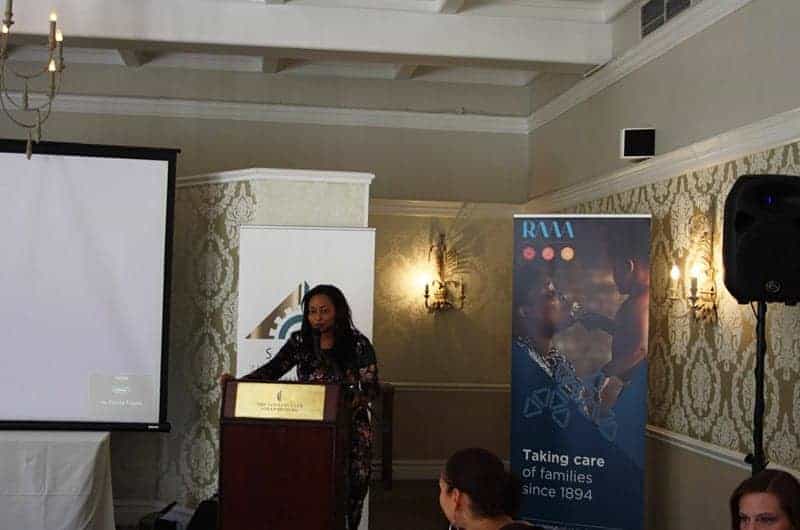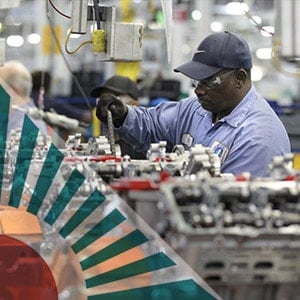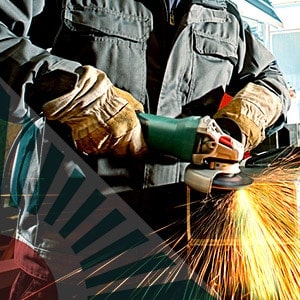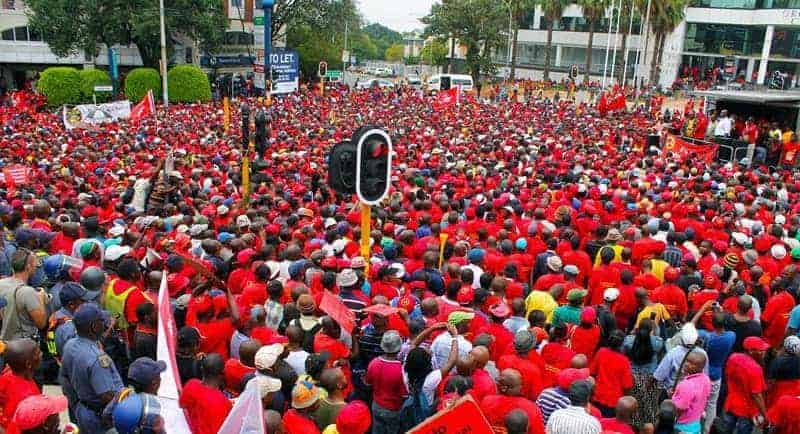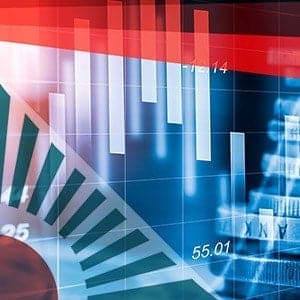GORDHAN, NAIDOO AND DUVENAGE TO SPEAK ON EFFORTS TO END THE SCOURGE OF CORRUPTION
Johannesburg, 20 August 2018 – Public Enterprises Minister Pravin Gordhan, Organisation Undoing Tax Abuse Executive Director Wayne Duvenage and Council for the Advancement of the South African Constitution Executive Secretary Lawson Naidoo will meet to hammer out solutions to deal with corruption in South Africa’s public and private sectors on the first day of the 2018 Southern African Metals and Engineering Indaba.
The last decade has seen the cancer that is corruption spread in both the public and private sectors, resulting not only in credit rating agencies downgrading South Africa, but also in halting South Africa’s sustainable economic, political and social progress.
The 2016 Transparency International Corruption Perceptions Index found that South Africa was ranked as the most corrupt country in Africa by respondents in the Global Corruption Barometer on Africa. The report identifies elevated levels of vulnerability in the private sector’s provision of services to State-owned companies and government departments.
Allegations of state capture, misdemeanor at State-owned entities such as Eskom as well felony at Steinhoff also serve as evidence of corruption that has stifled South Africa over the last decade.
Commenting on this plenary session, Steel and Engineering Industries Federation of Southern Africa (SEIFSA) Chief Executive Officer Kaizer Nyatsumba said business needs to adopt a zero-tolerance approach to corruption.
“As a country, we cannot afford to let corruption continue to spread unchallenged. Collectively, wehave an obligation to address corruption as a key factor that undermines our economic and social progress. It is against this backdrop that we have dedicated a plenary session to dealing with corruption,” said Mr Nyatsumba.
He said that while it was encouraging that the Ramaphosa administration so far appeared to have embarked on a commendable campaign to fight corruption, it was also important for business and civil society to be part of that campaign.
“The new administration cannot do it alone. Together with government and organised labour, we as the business community must act speedily and decisively against corruption and restore good governance in both the public and private sectors,” said Mr Nyatsumba.
Other topics that will take feature prominently during the 2018 Indaba include:
- Working Together to Improve South Africa’s Sovereign Credit Rating
- The Continental Free Trade Area: How Much Progress Has Been Made to Date?
- How much of the National Development Plan has been implemented – and is it still relevant?
- Exploring and Leveraging the Link Between the Metals and Engineering Sector and the Mining, Construction and Auto Manufacturing Industries
- Constraints to investing in the Metals and Engineering Sector and improving trade on the African continent
- Radical Economic Transformation, the Black Industrialists Programme and the Metals and Engineering Sector
- Innovation and Excellence as Strategic Levers for Global Competitiveness
- Administered Prices as Factors Negatively Affecting South Africa’s International Competitiveness: Can we Change the Situation?
President Cyril Ramaphosa is billed to deliver the opening address. Among the high-profile speakers expected to address the conference are:
- Cabinet Ministers Dr Nkosazana Dlamini-Zuma, Dr Zweli Mkhize, Nhlanhla Nene and Deputy President David Mabuza;
- Business leaders like Business Unity South Africa CEO Tanya Cohen, Black Business Council CEO Kganki Matabane, Arcelor Mittal General Manager: Africa Overland Alph Ngapo, Africa House Director Duncan Bonnett, Africa@Work CEO Dinna Games, Hazleton Pump International Managing Director Mathys Wehmer, former Atlantis Foundries CEO Pieter du Plessis, Eskom CEO Phakamani Hadebe, Transnet CEO Siyabonga Gama, PWC South Africa Director Andrew Shaw, National Association of Automobile Manufacturers of SA Director Nico Vermeulen and Master Builders Executive Director Roy Mnisi;
- Policy makers and civil service representatives like Department of Trade and Industry (Dti) Director-General Lionel October, and Dti Chief Director for Africa Multilateral Economic Relations Wamkele Mene;
- Representatives of global organisations like World Bank Group Lead Economist John Gabriel and International Finance Corporation Senior Investment Officer Paul Mukasa;
- Civil society leaders like Federation of Unions of South Africa General Secretary Dennis George and Council for Scientific and Industrial Research CEO Dr Thulani Dlamini;
- Politicians like ANC Economic Transformation Head Enoch Godongwana, Democratic Alliance Shadow Minister for Trade and Industry Geordin Hill-Lewis and DA Shadow Minister for Public Enterprises Natasha Mazzone; and
- academics like University of Stellenbosch Social Justice Chair and former Public Protector Professor Thuli Madonsela and University of the Free State Visiting Professor JP Landman.
The 2018 Indaba will take place on 20 – 21 September at the IDC Conference Centre in Sandton. For more details on the conference, please visit www.meindaba.seifsa.co.za.
Issued by:
Ollie Madlala
Communications Consultant
Tel: (011) 298 9411 / 082 602 1725
Email: ollie@seifsa.co.za
Web: www.meindaba. seifsa.co.za
A MILLION JOBS IN MANUFACTURING BY 2027 – A REALISTIC PLAN OR A PIPEDREAM?
Johannesburg, 12 August 2018 – Can South Africa’s manufacturing sector create a million jobs by 2027 amidst a stagnant economy and the much-anticipated fourth industrial revolution, which is likely to result in further mechanization within the sector, and a possible influx of imported goods from China as it seeks new markets following the current trade war with the US?
This question will take centre stage at the 2018 Southern African Metals and Engineering Indaba, which will take place at the IDC Conference Centre in Sandton on 20-21 September. Deliberating on this question and suggesting ways to make a million jobs target achievable will be Manufacturing Circle CEO Philippa Rodseth, SEIFSA Chief Economist Michael Ade, Highveld Structural Mill CEO Johan Burger and Department of Economic Development Deputy Director-General Zeph Nhleko.
Last year, the Manufacturing Circle launched its “Map to A Million New Jobs in a Decade” plan, with the organisation’s chairman André de Ruyter saying at the time: “If manufacturing can expand to 30% of GDP, between 800 000 and 1.1 million direct jobs can be created, with 5 to 8 times that number in indirect jobs,” he added. “Our ‘Map to a Million’ puts forward detailed proposals to deliver a million jobs in manufacturing in the next decade.”
In the past two decades, the manufacturing sector has shed half a million jobs. At just under 13%, it contributes less than half to GDP than is appropriate for South Africa’s stage of development.
“The Map to a million is an initiative we strongly support as a Federation representing companies operating in the metals and engineering cluster, which forms part of the broader manufacturing sector. We believe that, similar to mining and agriculture sectors, manufacturing is one of the backbones of South Africa’s economy.We are of the view that it is of paramount importance that South Africa reindustrializes and restores its manufacturing sector to its former glory, in the interest of economic growth and employment creation.
“It is, therefore, against this backdrop that we felt it was important to use the platform provided by the Indaba to critically review the initiative and find ways of ensuring that it succeeds,” SEIFSA Chief Executive Officer Kaizer Nyatsumba said.
Other topics that will take feature prominently during the 2018 Indaba include:
- Working Together to Improve South Africa’s Sovereign Credit Rating
- Public Corruption and Corporate Malfeasance in South Africa: What Needs to Be Done to End or Contain It?
- The Continental Free Trade Area: How Much Progress Has Been Made to Date?
- How much of the National Development Plan has been implemented – and is it still relevant?
- Exploring and Leveraging the Link Between the Metals and Engineering Sector and the Mining, Construction and Auto Manufacturing Industries
- Constraints to investing in the Metals and Engineering Sector and improving trade on the African continent
- Radical Economic Transformation, the Black Industrialists Programme and the Metals and Engineering Sector
- Innovation and Excellence as Strategic Levers for Global Competitiveness
- Administered Prices As Factors Negatively Affecting South Africa’s International Competitiveness: Can we Change the Situation?
President Cyril Ramaphosa is billed to deliver the opening address. Among the high-profile speakers expected to address the conference are:
- Cabinet Ministers Dr Nkosazana Dlamini-Zuma, Dr Zweli Mkhize, Nhlanhla Nene, Pravin Gordhan and Deputy President David Mabuza;
- Business leaders like Business Unity South Africa CEO Tanya Cohen, Black Business Council CEO Kganki Matabane, ArcelorMittal General Manager: Africa Overland Alph Ngapo, Africa House Director Duncan Bonnett, Africa@Work CEO Dinna Games, Hazleton Pump International Managing Director Mathys Wehmer, former Atlantis Foundries CEO Pieter du Plessis, Eskom CEO Phakamani Hadebe, Transnet CEO Siyabonga Gama, PWC South Africa Director Andrew Shaw, National Association of Automobile Manufacturers of SA Director Nico Vermeulen and Master Builders Executive Director Roy Mnisi;
- Policy makers and civil service representatives like Department of Trade and Industry (Dti) Director-General Lionel October, and Dti Chief Director for Africa Multilateral Economic Relations Wamkele Mene;
- Representatives of global organisations like World Bank Group Lead Economist John Gabriel and International Finance Corporation Senior Investment Officer Paul Mukasa;
- Civil society leaders like Federation of Unions of South Africa General Secretary Dennis George, Organisation Undoing Tax Abuse Executive Director Wayne Duvenage, Council for the Advancement of the South African Constitution Executive Secretary Lawson Naidoo and Council for Scientific and Industrial Research CEO Dr Thulani Dlamini;
- Politicians like ANC Economic Transformation Head Enoch Godongwana, Democratic Alliance Shadow Minister for Trade and Industry Geordin Hill-Lewis and DA Shadow Minister for Public Enterprises Natasha Mazzone; and
Academics like University of Stellenbosch Social Justice Chair and former Public Protector Professor Thuli Madonsela and University of the Free State Visiting Professor JP Landman.
For more details on the conference, please visit www.meindaba.seifsa.co.za.
Issued by:
Ollie Madlala
Communications Consultant
Tel: (011) 298 9411 / 082 602 1725
Email: ollie@seifsa.co.za
Web: www.meindaba. seifsa.co.za
SEIFSA WELCOMES INCREASE IN METALS AND ENGINEERING SECTOR OUTPUT
Johannesburg, 7 August 2018 – The Steel and Engineering Industries Federation of Southern Africa (SEIFSA) welcomes a second consecutive increase in output of the metals and engineering (M&E) cluster in two months, SEIFSA Economist Marique Kruger said.
Speaking after the release of the latest preliminary seasonally-adjusted data, Ms Kruger said the increase in production in June, which follows a similar upward trend in May, is welcome, despite lingering concerns about the possibility of a lower-than-expected contribution of the broader manufacturing sector to gross domestic product (GDP) in the second quarter of the year.
“The data, released by Statistics South Africa today, captures an increase in output in the sub-industry, in line with the broader manufacturing sector, which also increased by 0,7% in June 2018 when compared with June 2017. After adjusting for the sectoral weights, the data indicated that production in M&E sub-sectors increased by 4,1% in June 2018 on a year-on-year basis, and by 2,4% on a month-on-month basis,” Ms Kruger said.
She said notwithstanding the general increase in gross output, concerns remain that the contribution of the cluster and the broader manufacturing to GDP is still negligible because of proportionately higher intermediate input prices and production costs, including fuel and energy costs.
Ms Kruger said input prices can be very volatile because of factors affecting supply, including the unpredictable exchange rate. Moreover, the demand for intermediate input tends to be more price inelastic, with overall demand remaining about the same whether input prices increase or decrease. She said this made it easier for suppliers to pass on frequent price increases to producers or buyers since their demand remained more or less the same, thereby accounting for the volatility in input prices.
She said the rapid depreciation of the rand-dollar exchange rate also increased the price of imported intermediary inputs and adversely affected the M&E cluster’s contribution to GDP.
Nevertheless, Ms Kruger said the improvement in gross output augurs well for local producers, amidst escalating trade war rhetoric as the US and China continue to exchange threats of further tariff increases.
“The expectation is for the positive output trend to continue in July 2018 in line with an improving domestic manufacturing index, which rose to 51,5 in July from 47,9 in June, signaling an expansion in local production activities. The improvement in the local manufacturing purchasing managers’ index to an expansionary territory aligns with the global manufacturing index, which continues to perform well at 52,7, remaining above the neutral 50-point mark for a sixth consecutive month,” she said. Ms Kruger said a positive local output growth trajectory – which is consistent with global trends – bodes well for the M&E cluster. She promised that SEIFSA would continue to monitor the trend.
Issued by:
Ollie Madlala
Communications Consultant
Tel: (011) 298 9411 / 082 602 1725
Email: ollie@seifsa.co.za
Web: www.seifsa.co.za
SEIFSA is a National Federation representing 23 independent employers. Associations in the metals and engineering industries, with a combined membership of 1600 companies employing around 200 000 employees. The Federation was formed in 1943 and its member companies range from giant steel-making corporations to formed in 1943 and its member companies range from giant steel-making corporations to micro-enterprises employing few than 50 people.
MAIN POLITICAL PARTIES TO ADDRESS 2018 INDABA DELEGATES
Johannesburg, 5 August 2018 – South Africa’s prominent political parties will get an opportunity to unpack their economic manifestos to business leaders attending the 2018 Southern African Metals and Engineering Indaba, scheduled to take place on 20-21 September at the IDC Conference Centre in Sandton.
The African National Congress’s Minister of Cooperative Governance and Traditional Affairs Dr Zweli Mkhize, his colleague Enoch Godongwana who heads the Economic Transformation Committee, along with the Democratic Alliance’s Shadow Minister for Trade and Industry Geordin Hill-Lewis and Inkatha Freedom Party’s Head of Energy, Trade and Industry and Mineral Resources Jan Adriaan Esterhuizen, will tell the business community how their political parties will turn the economy around.
Commenting on this important plenary session, which will take place on the second day of the Indaba, Steel and Engineering Industries Federation of Southern Africa (SEIFSA) Chief Executive Officer Kaizer Nyatsumba said the Federation felt that it was of critical importance that the main political parties are given an opportunity to outline their plans for the economy ahead of the 2019 General Elections.
“Over the last decade, South Africa’s economy has been dealt many painful blows, including sovereign credit downgrades, stagnant growth and a jobs bloodbath in critical sectors including mining, manufacturing and our very own metals and engineering sector. It goes without saying, therefore, that whoever gets to govern the country in 2019 has a mammoth task of ensuring that a conducive environment is created for South Africa’s economic fortunes to be turned around for the better,” My Nyatsumba said.
He said that in South Africa, like in other parts of the world, an obvious relationship between business and politics exists since Government’s policies have a direct impact on how business is conducted in the country, which is why business leaders continuously lobby politicians for policies conducive for businesses sustainability and growth.
“Therefore, it is against this backdrop that we have decided to invite political parties to address the business community attending this year’s Indaba,” Mr Nyatsumba explained.
Other topics that will take centre stage during the 2018 Indaba include:
- Working Together to Improve South Africa’s Sovereign Credit Rating
- Public Corruption and Corporate Malfeasance in South Africa: What Needs to Be Done to End or Contain It?
- The Continental Free Trade Area: How Much Progress Has Been Made to Date?
- How much of the National Development Plan has been implemented – and is it still relevant?
- Exploring and Leveraging the Link Between the Metals and Engineering Sector and the Mining, Construction and Auto Manufacturing Industries
- Constraints to investing in the Metals and Engineering Sector and improving trade on the African continent
- Radical Economic Transformation, the Black Industrialists Programme and the Metals and Engineering Sector
- Innovation and Excellence as Strategic Levers for Global Competitiveness
- The Manufacturing Circle’s “Map to a Million New Jobs in a Decade”: A Realistic Plan or An Empty Promise?
- Administered Prices As Factors Negatively Affecting South Africa’s International Competitiveness: Can we Change the Situation?
President Cyril Ramaphosa is billed to deliver the opening address. Among the high-profile speakers expected to address the conference are:
- Cabinet Ministers Dr Nkosazana Dlamini-Zuma, Dr Zweli Mkhize, Nhlanhla Nene, Pravin Gordhan and Deputy President David Mabuza;
- Business leaders like Business Unity South Africa CEO Tanya Cohen, Black Business Council CEO Kganki Matabane, Manufacturing Circle CEO Philippa Rodseth, ArcelorMittal General Manager: Africa Overland Alph Ngapo, Africa House Director Duncan Bonnett, Africa@Work CEO Dinna Games, Highveld Steel CEO Johan Burger, Hazleton Pump International Managing Director Mathys Wehmer, former Atlantis Foundries CEO Pieter du Plessis, Eskom CEO Phakamani Hadebe, Transnet CEO Siyabonga Gama, PWC South Africa Director Andrew Shaw, National Association of Automobile Manufacturers of SA Director Nico Vermeulen and Master Builders Executive Director Roy Mnisi;
- Policy makers and civil service representatives like Department of Trade and Industry (Dti) Director-General Lionel October, Dti Chief Director for Africa Multilateral Economic Relations Wamkele Mene and Department of Economic Development Deputy Director-General Zeph Nhleko;
- Representatives of global organisations like World Bank Group Lead Economist John Gabriel and International Finance Corporation Senior Investment Officer Paul Mukasa;
- Civil society leaders like Federation of Unions of South Africa General Secretary Dennis George, Organisation Undoing Tax Abuse Executive Director Wayne Duvenage, Council for the Advancement of the South African Constitution Executive Secretary Lawson Naidoo and Council for Scientific and Industrial Research CEO Dr Thulani Dlamini;
- Politicians like ANC Economic Transformation Head Enoch Godongwana, Democratic Alliance Shadow Minister for Trade and Industry Geordin Hill-Lewis and DA Shadow Minister for Public Enterprises Natasha Mazzone; and
Academics like University of Stellenbosch Social Justice Chair and former Public Protector Professor Thuli Madonsela and University of the Free State Visiting Professor JP LandmanFor more details on the conference, please visit www.meindaba.seifsa.co.za.
Issued by:
Ollie Madlala
Communications Consultant
Tel: (011) 298 9411 / 082 602 1725
Email: ollie@seifsa.co.za
Web: www.meindaba. seifsa.co.za
Rebound In The Purchasing Managers’ Index For July 2018 After Months Of Subdued Performance Is Encouraging
Johannesburg, 1 August 2018 – The rebound in overall business activity in the broader manufacturing sector is encouraging and bodes well for the future, the Steel and Engineering Industries Federation of Southern Africa (SEIFSA) said today.
Commenting after the release of the latest Absa Purchasing Managers’ Index (PMI), SEIFSA Economist Marique Kruger said the results of the lead indicator for August, which provides forward-looking insight into manufacturing’s health, were encouraging.
The index improved from 47.9 percent in June 2018 to 51.5 percent in July 2018, placing the data above the neutral level of 50, which separates expansion from contraction. Ms Kruger said the improvement provided some relief following two consecutive decreases in May and June 2018, and that it was expected that it would also have a positive knock-on effect on output levels.
“The PMI data specifically provide hope and modified expectations for companies in the metals and engineering (M&E) cluster going into the month of August, especially given that all the sub-indices improved in July relative to June,” said Ms Kruger.
Ms Kruger said it was particularly encouraging that the employment sub-index improved from 46.0 percent in June to 50.8 percent in July, providing hope for an eventual improvement in the unemployment rate. She said that was important following Tuesday’s release of the Quarterly Labour Force Survey results which captured a total loss of 105 000 jobs in the manufacturing sector, which compounded the official unemployment rate to 27.2% in the second quarter of 2018.
Ms Kruger said the PMI data continued to reflect the burden of fluctuating input costs, fuel and energy costs borne by manufacturers, largely underpinned by the weaker rand.
“We welcome the data and hope for a continuous improvement in business activity in the short term, as the information provides some promising indications for the broader manufacturing sector, which has the largest indirect job creation potential,” she said.
Ends
Issued by:
Ollie Madlala
Communications Consultant
Tel: (011) 298 9411 / 082 602 1725
Email: ollie@seifsa.co.za
Web: www.seifsa.co.za
SEIFSA Member Companies And The Constitutional Court Judgment On Labour Brokers
The Constitutional Court Ruling on Labour Brokers may mistakenly have created the perception that all clients of labour brokers become the sole employer of employees who earn below R205 433.30 per annum after three months.
Whilst we take no issue with this point, nevertheless it is important for companies that are members of one of the 21 Employer Associations affiliated to SEIFSA to understand that, as members of Employer Associations affiliated to SEIFSA which are party to the 2017-2020 Metal and Engineering Industry Collective Main Agreement concluded last year and adopted as a collective agreement concluded in a bargaining council, nothing has changed. For them, it is business as usual.
Attention is drawn to the following key points of the Judgment:
- Section 198A of the Labour Relations Act does not apply to labour broker employees who earn in excess of the earnings threshold (currently R205 433.30 per annum).
- The deeming provision contained in section 198A (3)(b)(i) of the LRA is only triggered if the labour broker employee is not performing a temporary service. A temporary service means work for a client by an employee:
- For a period not exceeding three (3) months;
- As a substitute for an employee of a client who is temporarily absent; or
- In a category of work for any period of time which is determined to be a temporary service by a collective agreement concluded in a bargaining council, a sectoral determination or a notice published by the Minister.
The 2017-2020 Consolidated Main Agreement, which has since been adopted as an industry agreement concluded in a bargaining council, in terms of section 31 of the Labour Relations Act, specifically addresses the relationship between labour brokers and their clients. Clause 20 of the Main Agreement permits the contracting of employees to a client via a labour broker for reasons related to site work, turnaround work, ship-repair work and short-term fluctuations in workload linked to time or the completion of the specific work, project or job detailed in the contract.
- If a placed employee is performing a temporary service (as defined above), the labour broker will, for as long as the placed employee performs a temporary service, remain the employer in terms of the LRA.
- The deeming provision provided for in s 198A (3) (b) (i) of the LRA is limited to theLabour Relations Act only. If the s 198A deeming provision is triggered, it does not mean, by way of an example, that the client also becomes the employer for the purposes of the BCEA, SDL and COIDA.
- If a placed employee is deemed to be an employee of the client, he/she must be treated on the whole not less favourably than an employee of the client performing the same or similar work, unless there is a justifiable reason for different treatment (this has been in place since 1 January 2015).
The MEIBC Main Agreement has never differentiated between the labour broker’s employees and permanent or temporary employees of a client; when it comes to terms and conditions of employment, both are treated in exactly the same manner.
- If section 198A (3)(b)(i) of the Labour Relations Act is triggered, the client of the labour broker becomes the sole employer of the placed employee. This is for the purposes of the LRA only.
- According to the Constitutional Court, there will be what is referred to as a triangular relationship. There is no “transfer to a new employment relationship, but rather a change in the statutory attribution of responsibility as the employer within the same triangular employment relationship.The triangular relationship then continues for as long as the commercial contract between the TES and the client remains in force and requires the TES to remunerate the workers.”
- Even with the sole employer interpretation, “a placed employee will retain the right to claim against a Temporary Employment Service (TES) through section 198(4A) to the extent that they are still remunerated by the TES. The employee is largely protected against the TES regardless of whether the claim is made against an employer. But this liability relates only to claims brought by the employee. The protections afforded by the sole employer interpretation go beyond this. They give employees certainty and security of employment.”
As long as an employer is a member of one of the 21-affiliated Employer Associations which signed the 2017-2020 Metal and Engineering Industry Main Agreement and is utilizing the services of a Labour Broker or TES which is a member of the Labour Broking Division (LBD) of the Constructional Engineering Association of SA (CEA),the exclusion principle continues to apply.
To join an Employer Association federated to SEIFSA, please call Ms Theresa Crowley on (011) 298-9419 or emailtheresa@seifsa.co.za.To contract with a Labour Broker or TES which is a member of the LBD or to join the Labour Broking Division of the CEA, please email Ms Christa Smith on christa@associationadministrator.co.za
Government Is Not The Only Solution To South Africa’s Unemployment Problem, Says SEIFSA
JOHANNESBURG, 31 JULY 2018 – The employment data released by Statistics South Africa (StatsSA) today is indicative of an economy under duress and highlights the mammoth task facing stakeholders in an upcoming jobs summit in the latter half of this year, Steel and Engineering Industries Federation of Southern Africa (SEIFSA) Chief Economist Michael Ade said.
Dr Ade said the results of the quarterly labour force survey (QLFS) – which is a household-based sample survey that captures labour market activities of persons aged 15-64 years – indicates an urgent need to address the fundamental factors inhibiting job creation in the country.
The employment data showed that the manufacturing sector, of which the metals and engineering (M&E) sector is part, lost 5,7 percent of total employment or an alarming 105,000 jobs between Q1 2018 and Q2 2018, with employment, decreasing from 1 849 000 during the period spanning January to March to 1 744 000 during the period spanning April to May 2018.
The quarterly employment statistics showed that 55 000 jobs in total were lost on a year-on-year basis between April-June 2017 and April-June of 2018, amounting to a 3,1 percent decrease.
Dr Ade said although the general South African working-age population increased by 0,4 percent, the number of employed persons correspondingly declined by 90,000.
He said this was a cause for concern as the data officially raised the domestic unemployment rate to 27.2%, which runs counter to the objectives of the National Development Plan to reduce the unemployment rate to 15 percent by 2030.
“Considering the official unemployment rate for Q2 2018, which is a lag indicator, it is difficult to predict a huge turnaround in the much-anticipated Q2 GDP numbers, which shouldconfirm that SA is out of a technical recession,” Dr Ade said.
He said the decrease in employment highlighted subdued domestic demand conditions and structural challenges faced by most industrial sectors against the backdrop of an increasingly uncertain global growth. He said the situation was not helped by the fact that local companies have been operating with excess capacity and at sub-optimum production levels as they tried to minimise input costs, including uncontrollable fuel and energy costs. These had negatively impacted on both formal and informal employment numbers.
“The numbers further highlight the existing trade-off between two key macro-economic variables, employment and economic growth. Employment levels are generally supposed to increase or decrease on the back of higher or lower economic activity, and this has not been the case for a long time. SEIFSA is also concerned about the socio-economic impact of high levels of unemployment compounded by decreasing GDP-per-capita since 2016.
“It is increasingly clear that the onus of finding a lasting solution to the skyrocketing unemployment numbers does not only rest with the government. As we shift our focus to the up-coming jobs summit, the high unemployment rate provides food for thought for all South Africans, who have to collectively seek sustainable solutions to the unemployment problem. Accordingly, opportunity-driven (rather than necessity-driven) entrepreneurship should be encouraged since it caters largely to sustainable
informal employment,” Dr Ade said
NUMSA AND THE CALL FOR A NATIONAL SHUTDOWN ON 1 AUGUST 2018
Introduction
As you may be aware from media reports, the National Union of Metalworkers of South Africa (NUMSA) says it supports the call of a national shutdown which is expected to take place on 1 August 2018.
The march is expected to start in the City of Tshwane and proceed to the Union Buildings. The march is intended to raise awareness about violence and oppression against women and against capitalism.
Protest Action and the Labour Relations Act
The Labour Relations Act (LRA) permits registered trade unions such as NUMSA and the NUM to undertake protected protest action to promote the social and economic interests of workers, provided that they observe the procedural requirements contained in Section 77 of the LRA.
It is important to note that, on this occasion, no such application has been submitted to NEDLAC. Consequently, employees participating in any action on 1 August 2018 will not be protected by the normal rules regarding protected strikes. That means no work, no pay and no disciplinary action.
SEIFSA recommends that Management adopts the following course of action in dealing with any absence from work on 1 August 2018:
- no work and no pay, with the option of taking appropriate disciplinary action being implemented at Management’s discretion;
- a shift for Leave Pay and Leave Enhancement Pay qualification purposes will be lost in respect of the day’s absence; and
- any overtime worked during the course of the week will be paid at ordinary rates to make up for the loss of any ordinary working hours on 1 August 2018.
The Staff of the SEIFSA Industrial Relations and Legal Services Division are available on (011) 298-9400 to provide any further advice and/ or assistance to Management on the contents of this Management Brief.
SEIFSA WELCOMES CONTINUING IMPROVEMENT IN PPI FOR INTERMEDIATE MANUFACTURED GOODS OF THE METALS AND ENGINEERING SECTOR
Johannesburg, 26 July 2018 – The Steel and Engineering Industries Federation of Southern Africa (SEIFSA) welcomes the increase in the Producer Price Index (PPI) for intermediate manufactured goods published by Statistics South Africa (Stats SA) today. The continuous improvement in the data – which measures the average change in selling prices received by domestic producers – in the midst of a global trade war and increased prospects of less synchronised global growth and uncertainty is good for the metals and engineering (M&E) cluster, the Federation’s Chief Economist Michael Ade said.
The StatsSA data showed that the PPI for intermediate manufactured goods increased to 3,1 percent year on year in June 2018, from 0,2 percent recorded in May 2018. This is in line with a corresponding increase in the PPI for final manufactured goods for the broader manufacturing sector from 4,6 percent in May 2018 to 5,9 percent in June 2018. The performance provides some level of solace to local producers in the M&E cluster against the backdrop of worrisome tit-for-tat protectionist trade policies by the two largest economies in the world.
“The increase in both measures of domestic producer prices for June 2018 is welcome to businesses in this difficult economic environment characterised by high fuel prices, weaker exchange rate, lower retail sales and higher energy costs,” Dr Ade said.
He added that the improving selling price trend in June increases the chances of businesses being able to recover input costs by passing higher prices onto the market. This is important especially given that there was a corresponding dip in business confidence to 93.7 in June 2018 from 94.9 in June 2017, as captured by the South African Chamber of Commerce and Industry’s annual Business Confidence Index.
Issued by:
Ollie Madlala
Communications Consultant
Tel: (011) 298 9411 / 082 602 1725
Email: ollie@seifsa.co.za
Web: www.meindaba. seifsa.co.za

